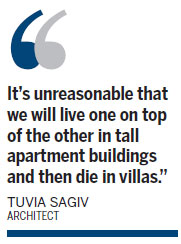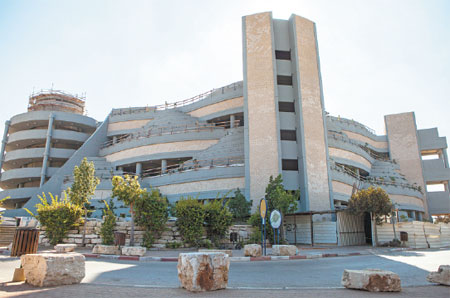Israel buries its dead in cemetery that's 22 m high
Multistory graveyards ease pressure on land in overcrowded urban areas
At first glance, the multi-tiered jungle of concrete off a major central Israeli highway does not appear unusual in this city of bland high-rises.
But the burgeoning towers are groundbreaking when you consider their future tenants: They will be homes not for the living, but for the dead.
With real estate at a premium, Israel is at the forefront of a global movement building vertical cemeteries in densely populated countries.
From Brazil to Japan, elevated cemeteries, sometimes stretching high into the sky, are providing the final resting place for thousands of people. They are now the default option for the recently departed in Israel.
After some initial hesitations, and rabbinical rulings that made the practice kosher, Israel's ultra-Orthodox burial societies have embraced the concept as the most effective Jewish practice in an era when most of the cemeteries in major population centers are packed full.
"The source of all this is that there is simply no room," said Tuvia Sagiv, an architect who specializes in dense burial design. "It's unreasonable that we will live one on top of the other in tall apartment buildings and then die in villas. If we have already agreed to live one on top of the other, then we can die one on top of the other."
The Yarkon Cemetery on the outskirts of Tel Aviv has been his flagship project. As the primary cemetery for the greater Tel Aviv area, its traditional burial grounds are at near-capacity with 110,000 graves stretched across 61 hectares.
But thanks to an array of 30 planned vertical structures, Sagiv said the cemetery will be able to provide 250,000 more graves without gobbling up any more land, providing the region with 25 years of breathing room.
"It takes some getting used to," he admitted, as he stood on the roof of the first completed 22-meter-high building. "But it just makes the most sense."
For now, the interior of the gray buildings looks mainly like a construction site. They feature circular ramps, and a terrace-like facade with vegetation. Each floor has openings on the sides to let in fresh air.
Vertical necropolis
Cemetery overcrowding presents a challenge the world over, particularly in cramped cities and among religions that forbid or discourage cremation. The reality of relying on finite land resources to cope with the endless stream of the dying has brought about creative solutions.
The world's tallest existing cemetery is the 32-story Memorial Necropole Ecumenica in Santos, Brazil. In Tokyo, the Kouanji is a six-story Buddhist temple where visitors can use a swipe card to have the remains of their loved ones brought to them from vaults on a conveyer belt system.
Versions of stacked cemeteries already exist in some shape or form in China, including the amphitheater-like Pok Fu Lam Road Cemetery in Hong Kong, as well as in New Orleans, across Europe, and in Egypt's Mountain of the Dead. Beijing residents have been given subsidies to buy space in vertical cemeteries.
But the future will probably look more like the ambitious plan of Norwegian designer Martin McSherry for an airy cemetery skyscraper that looks almost like a gigantic honeycomb with triangular caverns.
Other plans for cemetery towers have been presented for Paris and Mumbai.
In Mexico City, another big project has been proposed: the Tower for the Dead, combining a vertical necropolis and a 250-meter-deep subterranean complex.
But only in Israel does the phenomenon appear to be part of a government-backed master plan.
Aside from those who have already purchased their future plots, individual outdoor graves are no longer offered to the families of the more than 35,000 Israelis who die each year.
The first space-saving option is to put graves on top of each other - separated by a concrete divider - and have a shared headstone. This is common among couples and even whole families, and every new pit dug in Israel has room for at least two graves in it.
The second option is stacking the dead above ground in niches built into walls, a bit like a morgue, but adorned with headstones.
The third option is to be buried in a building where each floor resembles a traditional cemetery, without the blue sky above.

|
A new vertical part of the Yarkon cemetery stands outside the city of Petah Tikva, Israel. Cemetery overcrowding is an issue that resonates the world over, particularly in cramped cities and among religions that forbid or discourage cremation. Dan Balilty / Associated Press |
(China Daily 10/18/2014 page10)















